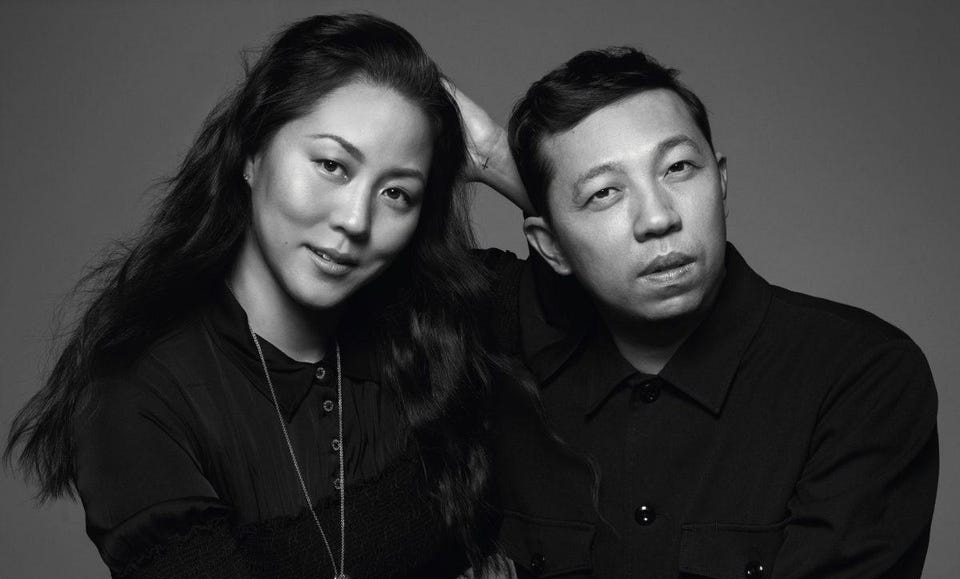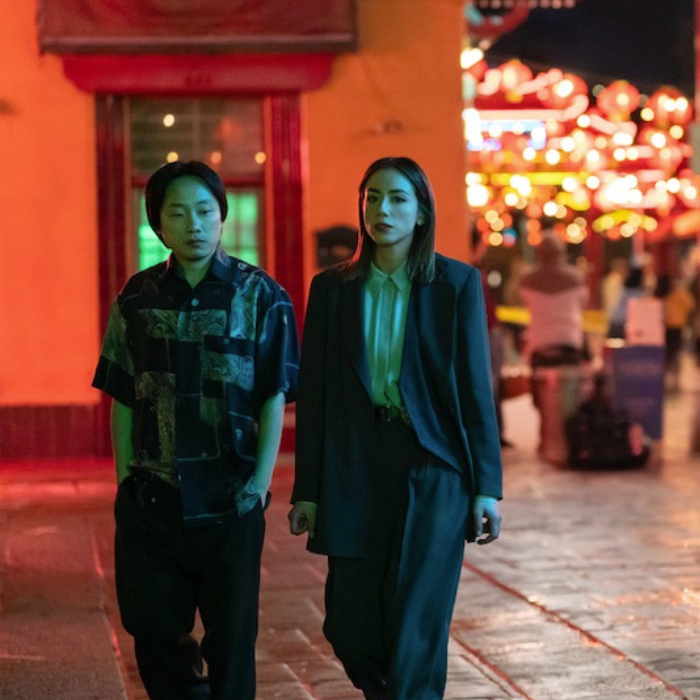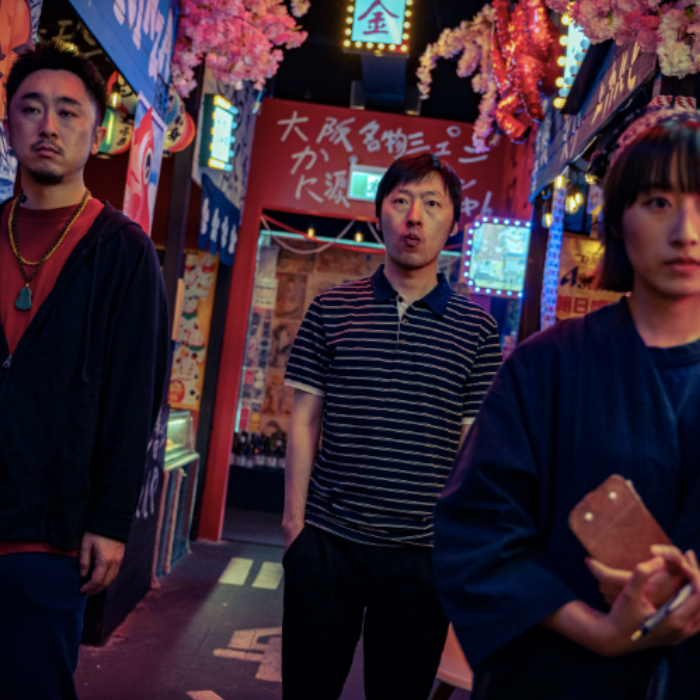United by their reverence for cultural history and unfettered curiosity, Carol Lim and Humberto Leon refuse to assimilate.
In tandem, the pair has made history uplifting narratives through fashion and retail that have long been misrepresented, if represented at all. Through their brand Opening Ceremony, they subverted the insular qualities of the luxury shopping experience while still creating exclusivity, concurrently nurturing the talents of AAPI creatives on the come up.
When they were tapped to become creative directors for the Parisian label Kenzo in 2011, retelling the story of Kenzō Takada’s eponymous brand—who was the first Asian designer to build a major Parisian fashion brand—was equal in importance to reinvention when modernizing the label for our interconnected, globalized world. Throughout their eight-year tenure at Kenzo, the duo championed diversity, notably casting 86 Asian models for their Summer 2018 runway show at Paris Fashion Week and weaving in the stories of immigrants that power the fashion industry.
In an expansive conversation with The RepresentASIAN Project‘s managing editor Nathan Sing, Lim and Leon reminisce about their past life as mallrats and spotlight the importance for creatives to live in accordance with their authentic story. Watch the full interview below, and read on for highlights.
[Humberto]…before your job [designing the window displays and floor setups] at GAP, fashion was alive in your home since your mother worked as a seamstress. Phillip Lim’s mom was also a seamstress, and he said in an interview that growing up in that environment, fashion never existed, it was survival, but he was always fixated with clothes. What role did your mom play in your early interest in fashion?
H.L.: Both of our parents really informed where Carol and I went with our careers. My mom sewed garments out of a sweatshop, but she was also very much about creating quality [garments], so I’ve always paired function and beauty. Because we didn’t have much money, she felt like what ever way we could express ourselves to show that we weren’t poor was very important. Beauty and function have always had a natural relationship. Carol’s parents were jewellers, so she had a very similar experience.
Carol Lim: Retail, engaging with customers, and just seeing how people react to their product was all part of my childhood. I used to work at the shop and watch my mom buy inventory. She would do the pricing, and she had this little trick. People always like to feel like they’re getting a bargain, so price it and then slash it so there would be a special price in red. So even if we didn’t know it at the time, these things really sunk in.
Because you watched them grow that business from the ground up, how involved were you with their business when you were younger?
C.L.: Early on, I got a job at the mall. I could have probably gone and worked at my parent’s store, but I didn’t want to do that. Kids go through this natural rebellion. But I would watch them sell and engage with their customers. People who would come back and they developed relationships, so that humanistic approach was something that I absorbed. And early on, I wanted to work and save up my own money, and the mall was our Haven. It was kind of a magical playground when we were growing up.
You two have this Yin Yang balance established in your professional and personal relationship. Was there a moment where you had this awareness of the unique synergy you have together?
C.L.: I would say from the very first encounter. Humberto was taking an art class with my roommate, and they came back home at like 10:00p.m. … it wasn’t even that late. But basically, I was in my pyjamas getting ready to go to bed, and they were going to go out dancing in San Francisco. Humberto was like, “You should come!” He basically convinced me to go out of my pyjamas. I threw on some heels, we went out, and it’s been like that ever since. On the rare occasion where Humberto’s like, “Oh, I’m just gonna be mellow,” somehow, that’s the night that I’m like, “We’re going out, we’re gonna do something.” We always had that relationship to help push each other.
H.L.: Let’s just say 30 years later, it really hasn’t changed.
After being primed with a corporate background, you pool together $20,000, get a matching loan and launch the first Opening Ceremony store in 2002. I heard you had a 50-page business plan typed up in a binder to get the loan, so did that go to plan? Do you remember what it was?
C.L.: Oh yeah, we still have it. We have the binder!
H.L.: We have most of the boxes checked off from that business plan. There was supposed to be this life-sized Lazy Susan that we could stand and that would flip into a DJ booth; that was one thing that was a genius idea that never came into fruition because of science and engineering. We also thought people were going to shop till two or three in the morning because we thought, why wouldn’t you want to do that? And I think we realized that people don’t want to shop till two or three in the morning.
C.L.: We also realized we would have to be there till two or three in the morning [laughs]. But yeah, we surpassed what we thought we would do. We had talked to other people who had small boutiques or businesses and mapped it all out so our inventory would last us six months. Everything was gone within the first three weeks, and we had to emergency shut the store. We had our friends cover a couple of shifts, and we had to go and call the designers and go back to Hong Kong—which was the first place we featured—to get more inventory. It was a good problem to have.
H.L.: We didn’t realize the potential of what we were doing. We were oddly creating this kind of drop culture or exclusive product without even knowing it. At the time, we wanted to make things no one else could get.
When you both created Opening Ceremony, it was so much more than an aesthetic or brand — you sought to create a feeling. What went into creating that feeling?
C.L.: One of the first things we knew was what we did not want it to feel like. It’s easier to make sure it doesn’t feel exclusive or that everything in the store is so precious. We wanted it to feel like what we enjoyed, which is thrifting and feeling like you can just try it on. It might not be your style, but just try it!
We would stay in the store and try everything on, and sometimes we come out laughing, and sometimes it’d be like, “Oh my god, surely I never would wear that, but I think I might.” We knew we wanted it to be somewhere we felt comfortable that our cousins, mothers, friends, and then obviously everyone who walked in, whether a celebrity, musician or someone in the fashion industry, would come and discover something. That was a good starting point, and that kind of openness and this feeling of treating everyone the same is what brought in lots of people to come and shop in the store. You would see a cross-section of all kinds of people shopping.
H.L.: We realized going into stores that there were so many things we didn’t like. Sales associates acting like you couldn’t afford anything, white clothing protected in plastic bags, the feeling like you do not belong. We were excited to have exclusive products without people feeling excluded from the experience. It was really about creating a community and a safe space that anyone could enjoy. We always say that you don’t have to buy anything, there is never any pressure. I love it the most when people come up and tell me that they tried on a bunch of clothes they could not afford while in college, and eventually, they became customers. We always tried to have things in the store that ranged in pricing, and we wanted to ensure everyone felt welcome.
That feeling in your stores also reverberated online with pieces like the iconic Opening Ceremony varsity jacket stopping all of us in our tracks. I remember everyone wanted the varsity jacket! And when the super large tote bag came out, everyone was sharing it on Instagram, saying this is the most hilarious, incredible thing.
H.L.: We were always creating stuff we wanted, and the varsity jacket is a good example. It was our 10th year anniversary, and we needed to create something for the staff because we treated the staff like our family. We wanted to create something for them so that they could feel like they were part of our club, and that’s how it started. The staff started wearing it out, and everyone emailed us asking how they would get one. At the time, Rihanna’s stylists had reached out and asked for a jacket, so we made her jacket. That’s what started it, she wore it, and then the demand was insane.
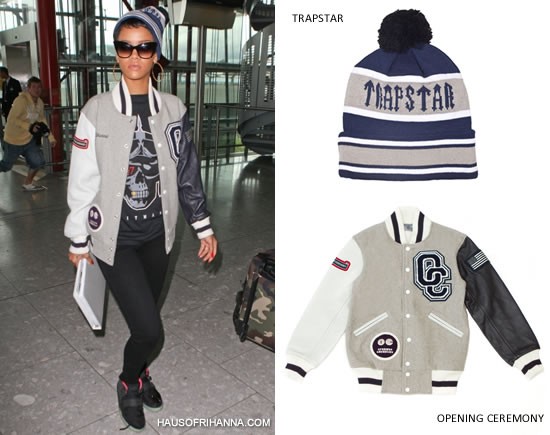
But it always begins with us. And we got one of those super large bags made because our vendor accidentally made this bag, and the specs were wrong. We got it in, and we were laughing so hard. I got inside the bag, Carol was carrying it, and we were just laughing. And so we made that bag due to a funny accident. It’s just about creating things we love that we find exciting and interesting.
That’s a story, and authentic storytelling is core to the work that you do together, whether it’s a fun story of joy or a lot deeper. How has that journey been finding a way to tell your story authentically through clothes, fashion and Opening Ceremony?
C.L.: What’s great is that clothing is one part of how we tell the story. When we started doing shows, we were excited because we suddenly had another way to express what the brand could be. We never just did a runway show; we created a cultural experience. We’re very much into weaving in all these different interests like music, film, food, travel, and authors. We’ve worked with so many different people that we’ve admired, and that have become friends with the brand. That’s what made it interesting, and also, as two people whose interests change and evolve, we take the brand with us on that journey. There are many brands that feel they can’t do that, and I think change becomes more of an obstacle. That’s a testament to just how we keep the brand changing. That’s the formula, which is there is no formula. That’s the beauty of it.
Another big part of what’s been important is we could talk about the things that are important to us, like being Asian, being gay, being a female, and having families. There are different things that, as we grow as humans, we can tell that story within the brand, which has been a really big part of me. It’s just natural to us. I think many brands now think that they have to align themselves, while for us, it’s like what is important to us? What should we support? What do we want to bring light to?
Clothing can be a vehicle for social change and celebrating culture. I was at a consignment store a month ago, and there was an Opening Ceremony jacket that had silk fabric with a traditional Chinese print. I was immediately reminded of wearing one of these traditional silk suits my Poh Poh and Gong Gong brought back for me from Hong Kong, which I was made fun of for wearing in Grade 2. After that, I never wore it again, and I’ve repressed that memory until recently.
When I saw that material, it was reclaimed in some sense in my mind to know that now it’s being sold in this store among all of these other garments. This fabric that I once had a stigmatized relationship with was now celebrated, and to know it’s part of my own culture was really powerful. So even a decade later, or whenever that jacket initially came out, for that to have impacted me like that really shows that on an individual level seeing a garment can really change someone’s outlook.
H.L.: We all grew up with a lot of those feelings, and I think that we never took for granted that we wanted to use Opening Ceremony to talk about a lot of these cultural challenges. A lot of times, we did use it as this positive motive to really reclaim the narrative and create change. We talk a lot about growing up and feeling the need to assimilate, but as we grew up, and as we started to really kind of form which we were, we felt this particular need to be anti-assimilation. Our culture and our background are what make us American; we don’t need to fit into this American stereotype, but by expressing our own identities, that’s what we contribute to America.
“…we wanted to use Opening Ceremony to talk about a lot of these cultural challenges. A lot of times, we did use it as this positive motive to really reclaim the narrative and create change. We talk a lot about growing up and feeling the need to assimilate, but as we grew up, and as we started to really kind of form which we were, we felt this particular need to be anti-assimilation. Our culture and our background are what make us American; we don’t need to fit into this American stereotype, but by expressing our own identities, that’s what we contribute to America.”
— Humberto Leon
Humberto, what did Kenzo Takada’s work and presence make possible in your mind in terms of what a gay Asian man was capable of achieving in the fashion world?
H.L.: The fact that he was an Asian founder of one of the oldest Maisons in Paris meant a lot to us, and then the fact that he was gay and very outspoken about it, and actually kind of flamboyant, I think made him all the more rich, because as we all know, in Asian culture people don’t talk about things or things are hidden under the rug You don’t talk about queerness or queer identity. So to have an out Asian man who founded a Maison in Paris was super exciting and really important to me as somebody who identifies as all those things. It was exciting for us to be able to take over that house and have us carry on the name.
Obviously, he had ran it for 20 some years, then it got bought by LVMH, and I think the story got lost. So in our tenure at Kenzo, we told his story through our eyes. So on parallel paths, telling his story and our story as immigrants in America was an exciting adventure to go on.
What was the most valuable thing you both learned while reimagining and reintroducing Kenzo to the world?
C.L.: Many people don’t know the history because many people would see us and think Humberto was Kenzo [laughs]. So you can imagine … and what an important story! And you have to dig deeper. The information is so quickly looked through unless you take the time to be curious about the history of who he was and what he created. We brought Kenzo, the brand, and Kenzō Takada, the designer, back into the cultural conversation.
H.L.: We also used the brand to talk about what was happening in the world and use that megaphone to talk about things that matter to us. We had one of the first all-Asian model shows of 87 models that were all-Asian because we were telling the story about two muses who were Asian, one was Kenzō Takada’s muse, and one was our muse. Seeing everybody backstage looking at each other and being like, “Holy shit, everyone in this cast is Asian!” And everyone just crying backstage … there’s a lot of nuance to what we were doing. If you really broke down every collection and every show that we did, we could really tell you that you were living through our lives. Whether it was the lead singer of The Cranberries dying to trying to get Bernie Sanders elected, we were using the stage in this very nuanced way. We were able to combine our love for our work and our beliefs.

Was there anything particularly inequitable within the industry at the time that you noticed and wanted to change?
H.L.: There are a lot of things that we still want to change. People think that we’ve progressed, and sure, I think we could maybe say we have. But I think that there’s so much to unpack. Because we had an American company, and then we were in Europe, I think that there are so many different notions of racial inequality throughout the world that we tried to address. Whether it was in our casting or the way we talked about the brand, or how we used the advertising, it was important for us to really start a narrative about a lot of those things.
I think that there are so many different notions of racial inequality throughout the world that we tried to address. Whether it was in our casting or the way we talked about the brand, or how we used the advertising, it was important for us to really start a narrative about a lot of those things.
— Humberto Leon
We started in 2012 at Kenzo, and the world was in a very different place than it is today. I remember the first thing we ever did was we shoot our first ad campaign with five black women, and there was definitely a conversation. Carol and I really kind of held strong, and we just said this is how we’re looking at the brand. We want it to be a brand where we can talk about things that are happening in this world. And we wanted to celebrate things and people that we felt like we wanted to celebrate.
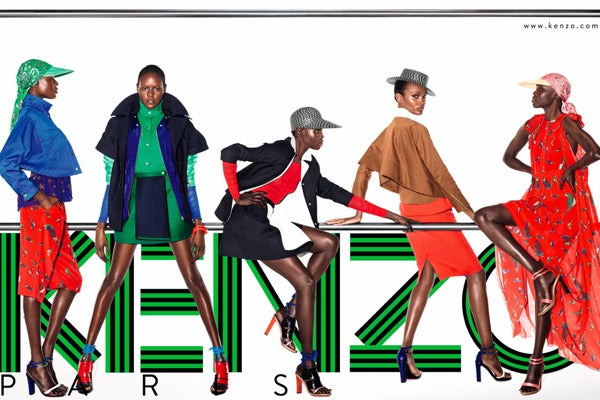
The core concept of Opening Ceremony celebrated what globalization enabled us to do. Since you launched the brand, the world has become an increasingly interconnected place, but that system is frail. What do you think the future of globalization looks like in this fracturing world?
C.L.: There is already a lot of talk and commitment around protecting the environment, and I think that needs to become a reality. Globalization has happened, and we’ve seen every big retail fast fashion company open in every major city, which wasn’t the case in 2002. There needs to be a real commitment around how we consume that’s going to have to start at an individual level. The government isn’t doing enough to put the protections in, so I think it’s going to need to start by asking yourself, what can you do? What are the choices you make? Who do you want to support?
H.L.: I also think we need ways of getting money back into the hands of people who are making things. Whether it’s unique cultures who have a craft and being able to give money back to them in order to buy truly authentic goods. That feels like a really beautiful way to think about the future of shopping or art, thinking about the makers and the creators of things.
You’ve told so many stories through fashion, stores, films, food, parties, and so many more mediums, weaving in your culture in everything you do. What stories can we expect you to tell next?
H.L.: Carol and I are very curious people, so we’re always excited about a lot of new things, and also about rediscovering old things. When I think about the youth, information is digested in such an interesting way, so there’s a way to kind of dive deep back into things in a way that I think could be really interesting. I feel really inspired and excited to think about how to tell stories while lifting up different communities. Giving back while moving forward.
This interview has been edited for length and clarity.
Like this post? Follow The RepresentASIAN Project on Instagram, TikTok and YouTube to keep updated on the latest content.







